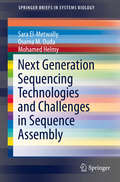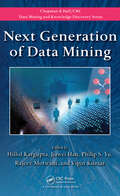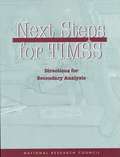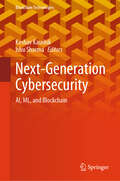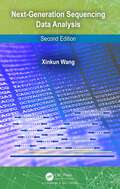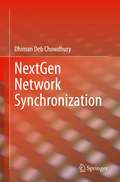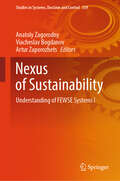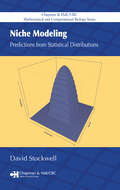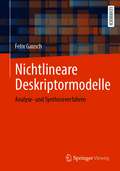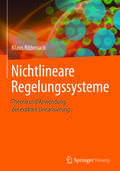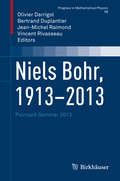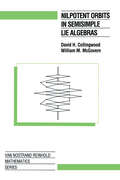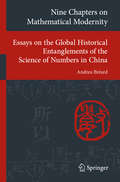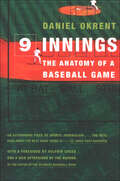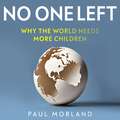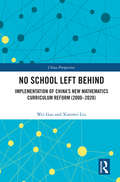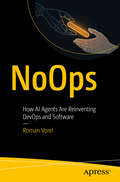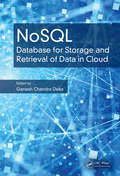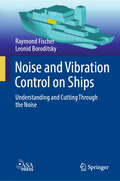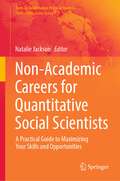- Table View
- List View
Next Generation Data Science: Second Southwest Data Science Conference, SDSC 2023, Waco, TX, USA, March 24–25, 2023, Revised Selected Papers (Communications in Computer and Information Science #2113)
by Henry Han Erich BakerThis book constitutes the refereed proceedings of the Sescond Southwest Data Science Conference, SDSC 2023, held in Waco, TX, USa, during March 24-25, 2023. The 16 full and 1 short paper included in this book were carefully reviewed and selected from 72 submissions. They were oragnized in topical sections named: Business social and foundation data science; and applied data science, artifiicial intelligence and data engineering.
Next Generation Sequencing Technologies and Challenges in Sequence Assembly
by Sara El-Metwally Osama M. Ouda Mohamed HelmyThe introduction of Next Generation Sequencing (NGS) technologies resulted in a major transformation in the way scientists extract genetic information from biological systems, revealing limitless insight about the genome, transcriptome and epigenome of any species. However, with NGS, came its own challenges that require continuous development in the sequencing technologies and bioinformatics analysis of the resultant raw data and assembly of the full length genome and transcriptome. Such developments lead to outstanding improvements of the performance and coverage of sequencing and improved quality for the assembled sequences, nevertheless, challenges such as sequencing errors, expensive processing and memory usage for assembly and sequencer specific errors remains major challenges in the field. This book aims to provide brief overviews the NGS field with special focus on the challenges facing the NGS field, including information on different experimental platforms, assembly algorithms and software tools, assembly error correction approaches and the correlated challenges.
Next Generation of Data Mining
by Jiawei Han Philip S. Yu Rajeev Motwani Vipin Kumar Hillol KarguptaDrawn from the US National Science Foundation's Symposium on Next Generation of Data Mining and Cyber-Enabled Discovery for Innovation (NGDM 07), Next Generation of Data Mining explores emerging technologies and applications in data mining as well as potential challenges faced by the field.Gathering perspectives from top experts across different di
Next Steps for TIMSS: Directions for Secondary Analysis
by Board on International Comparative Studies in EducationA report on Directions for Secondary Analysis
Next-Generation Cybersecurity: AI, ML, and Blockchain (Blockchain Technologies)
by Keshav Kaushik Ishu SharmaThis book highlights a comprehensive overview of the recent advancements and challenges in the field of cybersecurity with a focus on the integration of artificial intelligence (AI), machine learning (ML), and blockchain technologies. The book targets both researchers and practitioners working in the field of cybersecurity and aims to fill the gap in the current literature by providing a comprehensive and up-to-date examination of the integration of AI, ML, and blockchain in cybersecurity systems. The book has a technical focus and provides an in-depthexamination of the latest developments in the field. It covers a range of topics including the basics of AI, ML, and blockchain, the application of AI and ML in cybersecurity, the use of blockchain in cybersecurity, and the integrationof AI, ML, and blockchain in cybersecurity systems. Each chapter is written by leading experts in the field and provides a thorough and technical overview of the topic, including case studies, examples, and practical applications.
Next-Generation Sequencing Data Analysis
by Xinkun WangRNA-seq: both bulk and single-cell (separate chapters) Genotyping and variant discovery through whole genome/exome sequencing Clinical sequencing and detection of actionable variants De novo genome assembly ChIP-seq to map protein-DNA interactions Epigenomics through DNA methylation sequencing Metagenome sequencing for microbiome analysis
Next-Generation Sequencing: Standard Operating Procedures and Applications
by Prashanth N. Suravajhala Jeffrey W. BizzaroThis cutting-edge reference book compiles standard operating procedures, protocols, and applications of next-generation sequencing (NGS). It discusses genomic testing applications through NGS. It pays special focus on the protocols for cataloguing variants of uncertain significance. Over the years, NGS and advanced bioinformatics approaches have allowed the transition of genomic assays into translational practices. The book covers visualisation of NGS datasets, investigation of early development impairment, and metagenome protocols. It also discusses the challenges in NGS methods.Key Points: Includes case studies of application of NGS in different taxa like humans, rodents, plants, and bacteria Compiles protocols from various reputed companies like Illumina, PacBio, and ThermoFisher Discusses the translational applications of NGS methods Reviews machine learning heuristics for NGS data interpretation Discusses emerging genomic assay technologies and characterising mechanisms of disease prevalence The book is meant for researchers and industry experts in genomics, computational biology, and bioinformatics.Chapter 7 and 9 of this book is freely available as a downloadable Open Access PDF at http://www.taylorfrancis.com under a Creative Commons [Attribution-Non Commercial-No Derivatives (CC BY-NC-ND)] 4.0 license.
NextGen Network Synchronization
by Dhiman Deb ChowdhuryThis book presents time synchronization and its essential role as a conduit of optimized networks and as one of the key imperatives of ubiquitous connectivity. The author discusses how, without proper time synchronization, many mission critical infrastructures such as 5G mobile networks, smart grids, data centres CATV, and industrial networks would render in serious performance issues and may be subject to catastrophic failure. The book provides a thorough understanding of time synchronization from fundamental concepts to the application of time synchronization in NextGen mission critical infrastructure. Readers will find information not only on designing the optimized products for mission critical infrastructure but also on building NextGen mission critical infrastructure.
Nexus of Sustainability: Understanding of FEWSE Systems І (Studies in Systems, Decision and Control #559)
by Artur Zaporozhets Viacheslav Bogdanov Anatoly ZagorodnyThe intricate interplay between food, energy, water, societal dynamics, and the environment constitutes the bedrock of contemporary global challenges. In recent decades, this convergence has emerged as a focal point for scientific inquiry, policy formulation, and societal discourse. This book seeks to meticulously unravel the complexities inherent in this nexus, shedding profound light on the interconnected risks, vulnerabilities, and transformative opportunities that define our quest for sustainability in the twenty-first century. The materials of this book were prepared mainly by authors working on the joint project between the International Institute for Applied Systems Analysis (IIASA) and the National Academy of Sciences (NAS) of Ukraine “Integrated robust modeling and management of food-energy-water-land use nexus for sustainable development”, and on the project “Comprehensive analysis of robust preventive and adaptive measures of food, energy, water, and social management in the context of systemic risks and consequences of COVID-19” (0122U000552) of the NAS of Ukraine. Members of the System Analysis Committee of the NAS of Ukraine were also involved in the preparation of book chapters. The authors dedicate this book to the memory of the Academician of NAS of Ukraine, Professor Yuri Ermoliev, who died in October 2022 and made a fundamental contribution to stochastic optimization as a basic tool for quantitative risk management. This book largely follows his ideas about risk management and its applications.
Niche Modeling: Predictions from Statistical Distributions
by David StockwellUsing theory, applications, and examples of inferences, Niche Modeling: Predictions from Statistical Distributions demonstrates how to conduct and evaluate niche modeling projects in any area of application. It features a series of theoretical and practical exercises for developing and evaluating niche models using the R statistics language. The au
Nichtlineare Deskriptormodelle: Analyse- und Syntheseverfahren
by Felix GauschDieses Buch befasst sich mit der Entwicklung von Analyse- und Syntheseverfahren für nichtlineare Mehrgrößensysteme mit Modellen in Deskriptorform. Mit einem eigens für Deskriptormodelle eingeführten rekursiven Operator lassen sich die entwickelten Analyse- und Syntheseverfahren kompakt darstellen. Die Rolle dieses Operators im Rahmen von Deskriptormodellen entspricht derjenigen der Lie-Ableitung im Zusammenhang mit Zustandsmodellen. Im Anschluss an die Analyse der Strukturen und Eigenschaften von Deskriptormodellen werden die Schwerpunkte auf den Entwurf einer Rückführung zur exakten Linearisierung und Entkopplung des Eingangs-Ausgangsverhaltens, auf den Entwurf von Beobachtern zur Schätzung der Deskriptorvariablen und auf die Realisierbarkeit von verkoppelten Deskriptormodellen gelegt.
Nichtlineare Regelungssysteme: Theorie und Anwendung der exakten Linearisierung
by Klaus RöbenackDas Buch behandelt fortgeschrittene Methoden der nichtlinearen Regelungstheorie. Die Darstellung ist einerseits in sich mathematisch schlüssig und nachvollziehbar, andererseits aber auch in einer für Ingenieure verständlichen Sprache formuliert. Die jeweilige Herangehensweise bzw. Entwurfsmethodik wird an verschiedenen Beispielen veranschaulicht bzw. durch den Einsatz des Open-Source-Computeralgebrasystems Maxima illustriert.Die ZielgruppenDas Werk wendet sich an Doktoranden bzw. Ingenieure in der Industrie, die - z.B. im Bereich Automotive oder in der chemischen Industrie – mit der Regelung nichtlinearer Systeme konfrontiert werden. Das Buch richtet sich ebenso an Studierende der Elektrotechnik oder Mechatronik in der Vertiefungsrichtung Automatisierungs- bzw. Regelungstechnik, die bereits über fortgeschrittene regelungstechnische Kenntnisse verfügen.
Niels Bohr, 1913-2013
by Vincent Rivasseau Olivier Darrigol Bertrand Duplantier Jean-Michel RaimondThis fourteenth volume in the Poincaré Seminar Series is devoted to Niels Bohr, his foundational contributions to understanding atomic structure and quantum theory and their continuing importance today. This book contains the following chapters: - Tomas Bohr, Keeping Things Open; - Olivier Darrigol, Bohr's Trilogy of 1913; -John Heilbron, The Mind that Created the Bohr Atom; - Serge Haroche & Jean-Michel Raimond, Bohr's Legacy in Cavity QED; - Alain Aspect, From Einstein, Bohr, Schrödinger to Bell and Feynman: a New Quantum Revolution?; - Antoine Browaeys, Interacting Cold Rydberg Atoms: A Toy Many-Body System; - Michel Bitbol & Stefano Osnaghi, Bohr´s Complementarity and Kant´s Epistemology. Dating from their origin in lectures to a broad scientific audience these seven chapters are of high educational value. This volume is of general interest to physicists, mathematicians and historians.
Night Vision Processing and Understanding
by Lianfa Bai Jing Han Jiang YueThis book systematically analyses the latest insights into night vision imaging processing and perceptual understanding as well as related theories and methods. The algorithm model and hardware system provided can be used as the reference basis for the general design, algorithm design and hardware design of photoelectric systems. Focusing on the differences in the imaging environment, target characteristics, and imaging methods, this book discusses multi-spectral and video data, and investigates a variety of information mining and perceptual understanding algorithms. It also assesses different processing methods for multiple types of scenes and targets.Taking into account the needs of scientists and technicians engaged in night vision optoelectronic imaging detection research, the book incorporates the latest international technical methods. The content fully reflects the technical significance and dynamics of the new field of night vision. The eight chapters cover topics including multispectral imaging, Hadamard transform spectrometry; dimensionality reduction, data mining, data analysis, feature classification, feature learning; computer vision, image understanding, target recognition, object detection and colorization algorithms, which reflect the main areas of research in artificial intelligence in night vision.The book enables readers to grasp the novelty and practicality of the field and to develop their ability to connect theory with real-world applications. It also provides the necessary foundation to allow them to conduct research in the field and adapt to new technological developments in the future.
Nilpotent Orbits In Semisimple Lie Algebra: An Introduction
by William.M. McGovernThrough the 1990s, a circle of ideas emerged relating three very different kinds of objects associated to a complex semisimple Lie algebra: nilpotent orbits, representations of a Weyl group, and primitive ideals in an enveloping algebra. The principal aim of this book is to collect together the important results concerning the classification and properties of nilpotent orbits, beginning from the common ground of basic structure theory. The techniques used are elementary and in the toolkit of any graduate student interested in the harmonic analysis of representation theory of Lie groups. The book develops the Dynkin-Konstant and Bala-Carter classifications of complex nilpotent orbits, derives the Lusztig-Spaltenstein theory of induction of nilpotent orbits, discusses basic topological questions, and classifies real nilpotent orbits. The classical algebras are emphasized throughout; here the theory can be simplified by using the combinatorics of partitions and tableaux. The authors conclude with a survey of advanced topics related to the above circle of ideas. This book is the product of a two-quarter course taught at the University of Washington.
Nine Chapters on Mathematical Modernity: Essays on the Global Historical Entanglements of the Science of Numbers in China (Transcultural Research – Heidelberg Studies on Asia and Europe in a Global Context)
by Andrea BréardThe book addresses for the first time the dynamics associated with the modernization of mathematics in China from the nineteenth to the mid-twentieth century from a transcultural global historical perspective. Rather than depict the transformations of mathematical knowledge in terms of a process of westernization, the book analyzes the complex interactions between different scientific communities and the ways in which the past, modernity, language, and mathematics were negotiated in a global context. In each chapter, Andrea Bréard provides vivid portraits of a series of go-betweens (such as translators, educators, or state statisticians) based on a vast array of translated primary sources hitherto unavailable to a non-Chinese readership. They not only illustrate how Chinese scholars mediated between new mathematical objects and discursive modes, but also how they instrumentalized their autochthonous scientific roots in specific political and intellectual contexts. While sometimes technical in style, the book addresses all readers who are interested in the global and cultural history of science and the complexities involved in the making of universal mathematics. “While the pursuit of modernity is in the title, entanglement is of as much interest. Using the famous ‘Nine Chapters’ as a framework, Bréard considers a wide range of that entanglement from divination to data management. Bréard’s analysis and thought-provoking insights show once again how much we can learn when two cultures intersect. A fascinating read!” (John Day, Boston University).
Nine Innings: The Anatomy of a Baseball Game
by Daniel OkrentBrewers-Orioles, 6/10/82: “An astounding piece of sports journalism . . . the best book about the best game there is.” —St. Louis Post-DispatchA timeless baseball classic, Nine Innings dissects a single baseball game played in June 1982—inning by inning, play by play. Daniel Okrent, New York Times–bestselling author and lifelong fan, chose as his subject a Milwaukee Brewers-Baltimore Orioles matchup, though it could have been any game, because, as Okrent reveals, the essence of baseball, no matter where or when it’s played, has been and will always be the same. In this particular moment of baseball history you will discover myriad aspects of the sport that are crucial to its nature but so often invisible to the fans—the hidden language of catchers’ signals, the physiology of pitching, the balance sheet of a club owner, the gait of a player stepping up to the plate. With the purity of heart and unwavering attention to detail that characterize our national pastime, Okrent goes straight to the core of the world’s greatest game. You’ll never watch baseball the same way again.“Informative and amusing . . . we get a little bit of everything and a lot of entertainment.” —TheNew York Times“Develop[s] a momentum that puts us on the edge of our seats . . . This is one of the best books ever on our national game.” —Ken Burns
No One Left: Why the World Needs More Children
by Paul MorlandA population calamity is unfolding before our eyes. It started in parts of the developed world and is spreading to the four corners of the globe. There are just too few babies being born for humanity to replace itself.Leading demographer Paul Morland argues that the consequences of this promise to be calamitous. Labour shortages, pensions crises, ballooning debt: what is currently happening in South Korea - which faces population decline of more than 85% within just two generations - threatens to engulf us all, and sooner than we think. In the developed world we may be able temporarily to stave off the worst of its effects with immigration, but many countries, including those the immigrants come from, will get old before they get rich.No One Left charts this future, explains its causes and suggests what might be done. Unless we radically change our attitudes towards parenthood and embrace a new progressive pro-natalism, argues Morland, we face disaster.
No School Left Behind: Implementation of China’s New Mathematics Curriculum Reform (2000–2020) (China Perspectives)
by Wei Gao Xianwei LiuBased on the fieldwork carried out at two elementary schools, Merits School and Pioneer School, in northeastern China, the monograph details how local schools enacted the New Mathematics Curriculum Reform that was launched in early 2000. The trajectory of the reform implementation at each school was plotted out. Both schools resorted to a long-standing quality control mechanism, i.e., teaching norms, to operationalize the reform ideas. The mechanism functioned by placing teachers under measurable supervision and evaluation aligned with the reform. The schools responded to the reform following school people’s raising practical concerns, as well as the established school culture. Merits School arrived at a "two-faced strategy" to cope with the reform. Pioneer School managed to maintain a balance between promoting reform pedagogy and maintaining good test rankings. Both schools marginally involved parents in the implementation of the reform. This study suggests that to achieve success, reformers need to place equal emphasis on the transformation of teachers as well as local policymakers. This book enriches the existing literature on the implementation of mathematics curriculum reform at the school level and brings insights into the schools’ implementation decisions, which will appeal to policymakers, curriculum researchers and administrators.
NoOps: How AI Agents Are Reinventing DevOps and Software
by Roman VorelTraditional DevOps is struggling with new challenges in today's fast-changing software world. With the rise of microservices, cloud-based systems, and AI-driven automation, managing software has become increasingly difficult. Teams often deal with too many tools, repetitive manual tasks, and slow innovation. NoOps provides a clear guide to using AI to streamline DevOps and reduce manual work. The book starts by explaining how DevOps has evolved and why software development has become so fragmented. It highlights the importance of standardization as the first step toward NoOps. Readers will learn how AI can improve coding, testing, infrastructure management, and software deployment. It covers AI-powered development tools, automated testing, self-managing infrastructure, and intelligent AI agents that handle deployments and fix problems automatically. Real-world case studies show how companies are already using AI to transform their DevOps processes. Beyond automation, NoOps also explores how AI will change job roles, requiring new skills and shifting how teams work. It discusses ethical concerns, team dynamics, and the future of AI-driven software development. Whether you're a developer, DevOps engineer, or tech leader, this book will help you understand and prepare for a future where AI plays a major role in software delivery. What you will learn: How DevOps has evolved and why traditional methods struggle with modern software challenges. How AI can automate coding, testing, and infrastructure management to streamline workflows. Explore AI-driven DevOps strategies, including AI orchestration, self-healing infrastructure, and predictive analytics. Discover real-world case studies of companies successfully using AI to improve software delivery. Who this book is for: Technical Executives, DevOps Engineers & SREs looking to automate testing, monitoring, infrastructure, and CI/CD. Software Developers who want to write better code faster using AI-driven development tools. QA Engineers & Testers responsible for functional, integration, and performance testing who need to automate and self-heal test cases with AI.
NoSQL: Database for Storage and Retrieval of Data in Cloud (Advances In Computers Ser. #Volume 109)
by Ganesh Chandra DekaThis book discusses the advanced databases for the cloud-based application known as NoSQL. It will explore the recent advancements in NoSQL database technology. Chapters on structured, unstructured and hybrid databases will be included to explore bigdata analytics, bigdata storage and processing. The book is likely to cover a wide range of topics such as cloud computing, social computing, bigdata and advanced databases processing techniques.
Noise Sensitivity of Boolean Functions and Percolation
by Christophe Garban Jeffrey E. SteifThis is a graduate-level introduction to the theory of Boolean functions, an exciting area lying on the border of probability theory, discrete mathematics, analysis, and theoretical computer science. Certain functions are highly sensitive to noise; this can be seen via Fourier analysis on the hypercube. The key model analyzed in depth is critical percolation on the hexagonal lattice. For this model, the critical exponents, previously determined using the now-famous Schramm–Loewner evolution, appear here in the study of sensitivity behavior. Even for this relatively simple model, beyond the Fourier-analytic set-up, there are three crucially important but distinct approaches: hypercontractivity of operators, connections to randomized algorithms, and viewing the spectrum as a random Cantor set. This book assumes a basic background in probability theory and integration theory. Each chapter ends with exercises, some straightforward, some challenging.
Noise and Randomness in Living System
by Sisir Roy Sarangam MajumdarThis book illustrates the role of randomness and noise in living organisms. Traditionally, the randomness and noise have been used in understanding signal processing in communications. This book is divided into two sections, the first of which introduces readers to the various types and sources of noise and the constructive role of noise in non-linear dynamics. It also analyses the importance of randomness and noise in a variety of science and engineering applications. In turn, the second section discusses in detail the functional role of noise in biological processes for example, in case of brain function at the level of ion channel, synaptic level and even at cognitive level. These are described in various chapters. One of the challenging issue finding the neuronal correlates of various meditative states is to understand how brain controls various types of noise so as to reach a state of synchronized oscillatory state of the brain corresponding to the state of Samadhi. This is described in details in one chapter called Noise, Coherence and meditation. The concept of noise and the role of randomness in living organism raise lot of controversy for last few decades. This is discussed in a separate chapter. Finally, the epistemic and ontic nature of randomness as discussed in physical science are investigated in the context of living organism.
Noise and Vibration Control on Ships: Understanding and Cutting Through the Noise
by Raymond Fischer Leonid BoroditskyThis book provides a guide for the marine community to understand and address the noise and vibration environment associated with ships. Controlling noise and vibration in an effective and optimal manner requires a comprehensive understanding of all the ship systems that are involved in achieving a quiet vessel. While there are numerous published articles addressing various components of shipboard noise and vibration, this represents the first comprehensive book on the subject. Beginning from the basic acoustics of noise and vibration, it builds to more complex considerations in undersea sound, ship design, and compliance. The book provides an understanding of the ‘source-path-receiver’ modelling of shipboard noise and vibration. It delivers an overview of how to select and optimize both noise and vibration control treatments along with design guidance and methods to demonstrate compliance with acoustic regulations. It reflects the knowledge gained by the authors consulting over 40years each on hundreds of vessels, and represents an invaluable resource for ship builders and marine engineers.
Non-Academic Careers for Quantitative Social Scientists: A Practical Guide to Maximizing Your Skills and Opportunities (Texts in Quantitative Political Analysis)
by Natalie JacksonThis book is a guide to non-academic careers for quantitative social scientists. Written by social science PhDs working in large corporations, non-profits, tech startups, and alt-academic positions in higher education, this book consists of more than a dozen chapters on various topics on finding rewarding careers outside the academy. Chapters are organized in three parts. Part I provides an introduction to the types of jobs available to social science PhDs, where those jobs can be found, and what the work looks like in those positions. Part II creates a guide for social science PhDs on how to set themselves up for such careers, including navigating the academic world of graduate school while contemplating non-academic options, and selling their academic experience in a non-academic setting. Part III offers perspectives on timelines for making non-academic career decisions, lifestyle differences between academia and non-academic jobs, and additional resources for those considering a non-academic route. Providing valuable insight on non-academic careers from those who have successfully made the transition, this volume will be an asset to graduate students, advisors, and recent PhDs, in quantitative social science.

